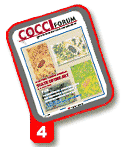Keeping Enteritis in Check
Birds vaccinated for coccidiosis may face enteritis threat, but losses are easy to avoid with good management and common sense
 Cherry: Live oocysts enable
them to develop immunity.
|
Many poultry producers believe
that chickens vaccinated for
coccidiosis are more susceptible
to necrotic enteritis than those
receiving in-feed coccidiostats.
According to Dr. Tim Cherry, poultry
veterinarian at Stephen F. Austin
State University, Nacogdoches, Tex.,
this belief comes from the fact that
birds vaccinated for coccidiosis receive
live oocysts that enable them to develop
immunity against coccidia organisms.
"For the vaccine to work, coccidial
organisms have to invade the intestinal
tract and reproduce, which stresses the
gut," he explains. "This irritation in the
gut can provide the environment necessary
for Clostridium perfringens -
already present in the gut "to produce
toxins that cause necrotic enteritis."
But that doesn't mean necrotic
enteritis can't be managed in birds vaccinated
for coccidiosis.
As Dr. Larry McDougald, professor
of poultry science and a parasitologist
at the University of Georgia, Athens,
puts it: "The vaccine isn't introducing
anything new into the matrix."
Tapping Natural Resistance
Most birds are exposed to coccidia
whether they receive the vaccine or
not, so they're naturally vulnerable to
C. perfringens infection. In the end,
poultry specialists say, it all comes
down to good management and common
sense for keeping necrotic enteritis
in check "regardless of whether
birds are vaccinated or medicated for
coccidiosis.
While it's true that coccidia -
whether acquired naturally or through
vaccination "introduce live parasitic
organisms into the intestinal tract of
birds, birds exposed to oocysts by vaccination
get a controlled dose of known
type, says Dr. Linnea Newman, a consulting
poultry veterinarian based in
North River, N.Y.
By following proven management
techniques and providing proper bird
space, adequate ventilation and
reduced litter picking, producers can
help the parasites cycle through the
healthy bird's system while tapping its
own natural defenses to reduce the
threat of necrotic enteritis, she adds.
"We see a minimum of lesions with
Coccivac-B when birds are handled
well and the full level of bacitracin, virginiamycin
and lincomycin is used
through at least day 17," stresses
Newman.
"But don't use antibiotics as a
crutch," she warns. "Necrotic enteritis
control has to start with good management
and sanitation, which will become
even more important as the poultry
industry backs off or eliminates in-feed
medications in response to growing
consumer demand for natural birds."
Using CE Products to Tame C. perfringens
Can natural competitive exclusion products (CE) be used to help control necrotic
enteritis caused by C. perfringens? |
Stay on Track
Factors ranging from grain type and
wet litter to vaccinations and ventilation
can also play a role in increasing irritation
in the gut, which in turn promotes
the growth of toxins resulting in necrotic
enteritis.
Follow this checklist to make sure
your control program is on the right
track:
 Irritation in the gut can help
C. perfringens produce toxins
that cause necrotic enteritis.
|
"� Fine tune diets. Cut back or eliminate
wheat, at least in the starter ration.
Wheat has been associated with an
increased incidence of necrotic enteritis,
says Cherry."The use of an antibiotic or growth
promotant helps hold down intestinal
irritation," adds Dr. Rex Bushong,
Texan Six Consulting Firm, San Angelo,
Tex. The full complement of vitamins,
minerals and trace minerals should be
part of the ration as well.
"� Lower bird density. "We're at about
.75 square foot per bird or 15 birds per
square meter," says Dr. Harry Danforth
of the USDA. "One square foot per bird
or 11 birds per square meter would
help control necrotic enteritis and may
be necessary to control necrotic enteritis
under antibiotic-free conditions."
"� Provide a cleaner environment. C.
perfringens is spread through feces, so
good sanitation is important.
"Physical cleaning is the cheapest
method of breaking the cycle of
clostridial diseases," Drs. R.A. Nortonand F.J. Hoerr of Auburn University
wrote in a recent article.1
If a flock has experienced diseases
such as necrotic enteritis, "the litter
should automatically be cleaned out
completely before any new flock is
brought onto the premises," they
report.
"� Check the litter. Field observations
indicate that high litter moisture
encourages necrotic enteritis, according
to Newman. Use an absorbent litter
material such as wood shavings or rice
hulls and maintain litter depth of at
least 3 inches. "The best way to control
litter moisture is to ventilate, ventilate,
ventilate," she adds.
If the litter is found to be alkaline,
which can result from applying lime, it
should be treated to adjust the pH
Cherry adds, "Changing the top of the
litter with litter acidifiers makes the
environment less suitable for bacterial
growth."
"� Control access to bacteria.
According to Newman, infection occurs
when bacterial numbers overwhelm
the flock's ability to resist infection.
One of the biggest factors in bacterial
access is litter picking.
"Growers should closely monitor
feed availability to avoid litter picking,"
says Newman. "Frequent disinfection of
water systems is also important."
"� Watch down time.
"Producers using
intense management, including crowding
birds and short down times of less
than 12 days between flocks, are asking
for trouble whether they're using an
antibiotic or vaccination program," says
Bushong. He recommends a minimum
of 14 days down time.
1. Poultry Digest, August/September, 1999.
Source: CocciForum Issue No.4, Schering-Plough Animal Health.







